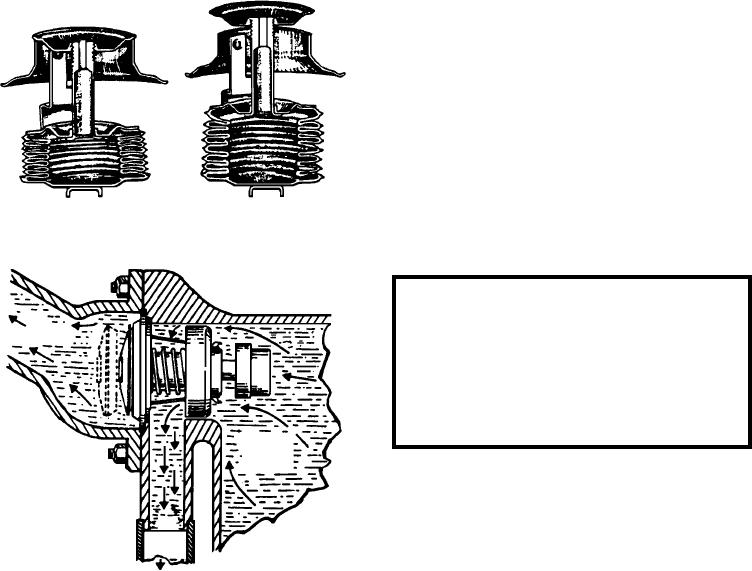
Overflow Tank
An overflow tank, sometimes referred to as a surge
tank or expansion tank, serves as a receptacle for
coolant forced out of the radiator overflow pipe and
provides for its return to the system. As the engine
cools, the balancing of pressures causes the coolant to
siphon back into the radiator. This requires a plain cap
on the radiator and a pressure cap on the overflow tank.
Cooling systems that use an overflow tank are
CLOSED
OPEN
known as closed cooling systems. Coolant is usually
ASf05007
Figure 5-7.--Bellows thermostat.
added to this system through the overflow tank, which
is marked for proper coolant level.
WARNING
Never remove the plain cap located on the radiator
TO
RADIATOR
unless you are positive the system is cold. If there
is any pressure in the radiator, it will spray you with
hot steam and coolant. Use extreme caution
whenever you work around a closed cooling
system.
ENGINE
WATER
JACKET
Temperature Gauge
The engine temperature gauge is made up of two
TO
WATER
principal parts: the gauge unit mounted on the
PUMP
instrument panel and the engine thermal unit. When
ASf05008
operated on the principle of the Bourdon tube, the
Figure 5-8.--Pellet thermostat.
temperature gauge is actuated by pressure from a bulb,
which is screwed into the water jacket of the engine.
temperature, most thermostats vary a few degrees in
The heat of the water vaporizes the liquid in the bulb,
the temperature at which they begin to open. In
and the vapors flow through a capillary, which is a very
addition, they may require a temperature from 20 to
small tube connecting the bulb to the gauge. The
25F higher before they are fully open. For instance, a
greater the heat, the more vapor is given off, the greater
thermostat designed to open at 150F might begin to
the pressure, and the higher the temperature indicated
open at any temperature between 146 and 154F. This
on the gauge.
same thermostat should be fully open at 170 to 175F.
When installing the temperature gauge or
Some stationary engines and large equipment are
repairing other parts of the engine, be careful not to
equipped with shutters that supplement the action of
kink the tube connecting the gauge and sending unit.
the thermostat in providing a faster warm up and in
Although it looks like an ordinary wire, this tube
maintaining proper operating temperatures. When the
contains the fluid that operates the gauge unit on the
engine coolant is below a predetermined temperature
instrument panel. A damaged temperature gauge must
(185 to 195F), the shutters, located in front of the
be replaced as a whole unit and cannot be repaired in
radiator, remain closed and restrict the flow of air
the shop.
through the radiator. Then, as the coolant reaches
proper temperature, the shutters start to open, allowing
Some vehicles are equipped with an electric
air to circulate through the radiator. The temperature
temperature gauge. The higher the temperature, the
of the coolant, when it reaches the predetermined
greater the current passing through the coils to the
temperature, causes the valve to expand, extending a
indicating unit, which, in turn, moves the needle to
rod that (through linkage) forces the shutters open.
register the engine temperature.
5-8

